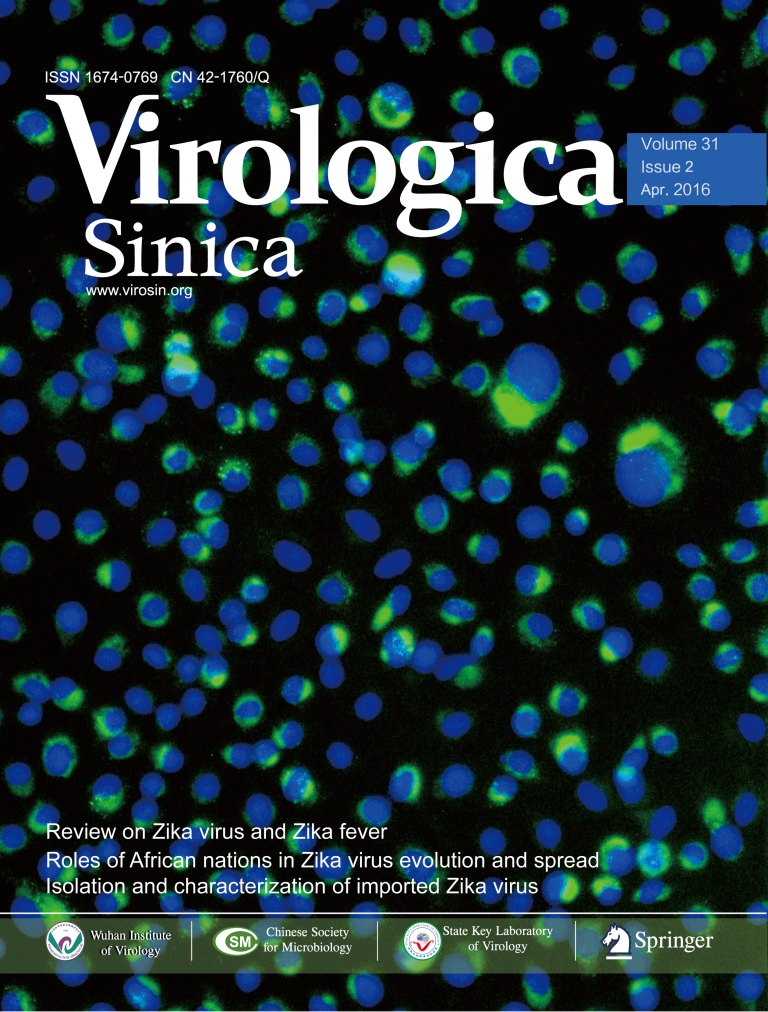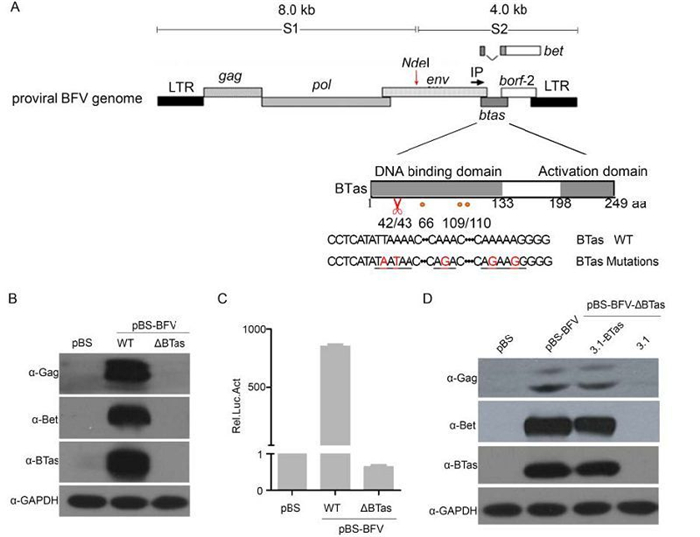-
Bannert H, Muranyi W, Ogryzko VV, Nakatani Y, Flugel RM. 2004. Coactivators p300 and PCAF physically and functionally interact with the foamy viral trans-activator. BMC Mol Biol, 5: 16.
doi: 10.1186/1471-2199-5-16
-
Bing T, Yu H, Li Y, Sun L, Tan J, Geng Y, Qiao W. 2014. Characterization of a full-length infectious clone of bovine foamy virus 3026. Virol Sin, 29: 94-102.
doi: 10.1007/s12250-014-3382-5
-
Bodem J, Krausslich HG, Rethwilm A. 2007. Acetylation of the foamy virus transactivator Tas by PCAF augments promoter-binding affinity and virus transcription. J Gen Virol, 88: 259-263.
doi: 10.1099/vir.0.82169-0
-
Broussard SR, Comuzzie AG, Leighton KL, Leland MM, Whitehead EM, Allan JS. 1997. Characterization of new simian foamy viruses from African nonhuman primates. Virology, 237: 349-359.
doi: 10.1006/viro.1997.8797
-
Cereseto A, Manganaro L, Gutierrez MI, Terreni M, Fittipaldi A, Lusic M, Marcello A, Giacca M. 2005. Acetylation of HIV-1 integrase by p300 regulates viral integration. EMBO J, 24: 3070-3081.
doi: 10.1038/sj.emboj.7600770
-
Chang R, Tan J, Xu F, Han H, Geng Y, Li Y, Qiao W. 2011. Lysine acetylation sites in bovine foamy virus transactivator BTas are important for its DNA binding activity. Virology, 418: 21-26.
doi: 10.1016/j.virol.2011.07.003
-
Col E, Caron C, Seigneurin-Berny D, Gracia J, Favier A, Khochbin S. 2001. The Histone Acetyltransferase, hGCN5, Interacts with and Acetylates the HIV Transactivator, Tat. J Biol Chem, 276: 28179-28184.
doi: 10.1074/jbc.M101385200
-
Guo HY, Liang ZB, Li Y, Tan J, Chen QM, Qiao WT. 2011. A new indicator cell line established to monitor bovine foamy virus infection. Virol Sin, 26: 315-323.
doi: 10.1007/s12250-011-3204-y
-
He M, Zhang L, Wang X, Huo L, Sun L, Feng C, Jing X, Du D, Liang H, Liu M, Hong Z, Zhou J. 2013. Systematic Analysis of the Functions of Lysine Acetylation in the Regulation of Tat Activity. PLoS One, 8: e67186.
doi: 10.1371/journal.pone.0067186
-
Johnson RH, Oginnusi AA, Ladds PW. 1983. Isolations and serology of bovine spumavirus. Aust Vet J, 60: 147-147.
-
Linial ML. 1999. Foamy viruses are unconventional retroviruses. J Virol, 73: 1747-1755
-
Liu J, Liu S, Chen Q, Geng Y. 1999. Borf-1 protein identified as a transcriptional transactivator of bovine foamy virus. Chin. Sci. Bull., 44.
-
Liu J, Wang S, Zhang L, Qiao W, Chen Q, Geng Y. 2000. Functional Analysis of Bovine Foamy Virus Accessory Protein and Borf-1 Responsive Elements in Long Terminal Repeat. Chin J Virol, 16: 9. (In Chinese)
-
Lochelt M, Flugel RM, Aboud M. 1994. The human foamy virus internal promoter directs the expression of the functional Bel 1 transactivator and Bet protein early after infection. J Virol, 68: 638-645.
-
Lochelt M, Zentgraf H, Flugel RM. 1991. Construction of an infectious DNA clone of the full-length human spumaretrovirus genome and mutagenesis of the bel 1 gene. Virology, 184: 43-54.
doi: 10.1016/0042-6822(91)90820-2
-
Lodewick J, Lamsoul I, Polania A, Lebrun S, Burny A, Ratner L, Bex F. 2009. Acetylation of the human T-cell leukemia virus type 1 Tax oncoprotein by p300 promotes activation of the NF-kappaB pathway. Virology, 386: 68-78.
doi: 10.1016/j.virol.2008.12.043
-
Ma Z, Qiao WT, Xuan CH, Xie JH, Chen QM, Geng YQ. 2007. Detection and analysis of bovine foamy virus infection by an indicator cell line. Acta Pharmacol Sin, 28: 994-1000.
doi: 10.1111/aphs.2007.28.issue-7
-
Mochizuki M, Akuzawa M, Nagatomo H. 1990. Serological survey of the Iriomote cat (Felis iriomotensis) in Japan. J Wildl Dis, 26: 236-245.
doi: 10.7589/0090-3558-26.2.236
-
Ott M, Schnolzer M, Garnica J, Fischle W, Emiliani S, Rackwitz HR, Verdin E. 1999. Acetylation of the HIV-1 Tat protein by p300 is important for its transcriptional activity. Curr Biol, 9: 1489-1492.
doi: 10.1016/S0960-9822(00)80120-7
-
Rethwilm A. 2010. Molecular biology of foamy viruses. Med Microbiol Immunol, 199: 197-207.
doi: 10.1007/s00430-010-0158-x
-
Saib A. 2003. Non-primate foamy viruses. Curr Top Microbiol Immunol, 277: 197-211.
-
Tan J, Hao P, Jia R, Yang W, Liu R, Wang J, Xi Z, Geng Y, Qiao W. 2010. Identification and functional characterization of BTas transactivator as a DNA-binding protein. Virology, 405: 408-413.
doi: 10.1016/j.virol.2010.05.037
-
Tan J, Qiao W, Xu F, Han H, Chen Q, Geng Y. 2008a. Dimerization of BTas is required for the transactivational activity of bovine foamy virus. Virology, 376: 236-241.
doi: 10.1016/j.virol.2008.03.029
-
Tan J, Wu K, Chang R, Chen Q, Geng Y, Qiao W. 2008b. Subcellular localization analysis of bovine foamy virus Borf1 protein, Virol Sin, 23. 37-42
doi: 10.1007/s12250-008-2893-3
-
Tobaly-Tapiero J, Bittoun P, Neves M, Guillemin MC, Lecellier CH, Puvion-Dutilleul F, Gicquel B, Zientara S, Giron ML, de The H, Saib A. 2000. Isolation and characterization of an equine foamy virus. J Virol, 74: 4064-4073.
doi: 10.1128/JVI.74.9.4064-4073.2000
-
Wang J, Guo HY, Jia R, Xu X, Tan J, Geng YQ, Qiao WT. 2010. Preparation of BFV Gag antiserum and preliminary study on cellular distribution of BFV. Virol Sin, 25: 115-122.
doi: 10.1007/s12250-010-3110-8
-
Zhang L, Qiao W, Liu S, Wang J, Chen Q, Geng Y. 2000. Regulatory elements that mediate transactivation by Tas in the internal promoter of bovine foamy virus. Chin J Virol, 16: 232-237. (In Chinese)













